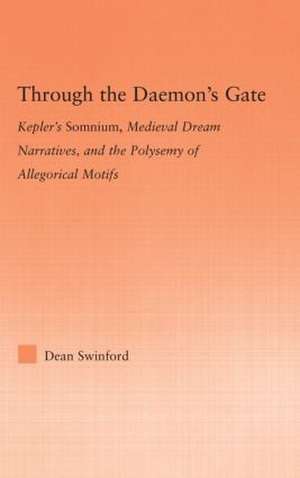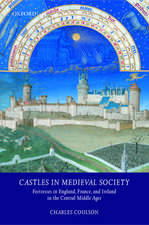Through the Daemon's Gate: Kepler's Somnium, Medieval Dream Narratives, and the Polysemy of Allegorical Motifs: Studies in Medieval History and Culture
Autor Dean Swinforden Limba Engleză Paperback – 28 oct 2010
Swinford develops a key claim about the form of the Somnium as it relates to early science: Kepler relies on a genre that is closely connected to a Ptolemaic, or earth-centered, model of the cosmos as a way of explaining and justifying a model of the cosmos that does not posit the same connections between the individual and the divine that are so important for the Ptolemaic model. In effect, Kepler uses the cosmic dream to describe a universe that cannot lay claim to the same correspondences between an individual’s dream and the order of the cosmos understood within the rules of the genre itself. To that end, Kepler’s Somnium is the first example of science fiction, but the last example of Neoplatonic allegory.
| Toate formatele și edițiile | Preț | Express |
|---|---|---|
| Paperback (1) | 435.59 lei 6-8 săpt. | |
| Taylor & Francis – 28 oct 2010 | 435.59 lei 6-8 săpt. | |
| Hardback (1) | 1059.84 lei 6-8 săpt. | |
| Taylor & Francis – 18 mai 2006 | 1059.84 lei 6-8 săpt. |
Din seria Studies in Medieval History and Culture
-
 Preț: 302.09 lei
Preț: 302.09 lei -
 Preț: 310.41 lei
Preț: 310.41 lei - 9%
 Preț: 1039.98 lei
Preț: 1039.98 lei - 9%
 Preț: 1013.20 lei
Preț: 1013.20 lei -
 Preț: 311.14 lei
Preț: 311.14 lei -
 Preț: 310.89 lei
Preț: 310.89 lei -
 Preț: 309.23 lei
Preț: 309.23 lei -
 Preț: 310.95 lei
Preț: 310.95 lei -
 Preț: 311.48 lei
Preț: 311.48 lei -
 Preț: 665.95 lei
Preț: 665.95 lei -
 Preț: 481.58 lei
Preț: 481.58 lei -
 Preț: 434.84 lei
Preț: 434.84 lei - 18%
 Preț: 998.71 lei
Preț: 998.71 lei - 18%
 Preț: 998.71 lei
Preț: 998.71 lei -
 Preț: 449.41 lei
Preț: 449.41 lei -
 Preț: 444.62 lei
Preț: 444.62 lei -
 Preț: 320.36 lei
Preț: 320.36 lei -
 Preț: 486.80 lei
Preț: 486.80 lei - 31%
 Preț: 767.47 lei
Preț: 767.47 lei - 18%
 Preț: 1109.18 lei
Preț: 1109.18 lei - 18%
 Preț: 1109.99 lei
Preț: 1109.99 lei - 18%
 Preț: 1002.80 lei
Preț: 1002.80 lei -
 Preț: 478.71 lei
Preț: 478.71 lei - 18%
 Preț: 997.27 lei
Preț: 997.27 lei - 18%
 Preț: 835.96 lei
Preț: 835.96 lei -
 Preț: 433.86 lei
Preț: 433.86 lei -
 Preț: 499.74 lei
Preț: 499.74 lei -
 Preț: 479.47 lei
Preț: 479.47 lei - 31%
 Preț: 766.31 lei
Preț: 766.31 lei -
 Preț: 443.65 lei
Preț: 443.65 lei -
 Preț: 444.51 lei
Preț: 444.51 lei -
 Preț: 323.23 lei
Preț: 323.23 lei - 18%
 Preț: 1000.27 lei
Preț: 1000.27 lei - 12%
 Preț: 325.34 lei
Preț: 325.34 lei - 26%
 Preț: 763.97 lei
Preț: 763.97 lei - 18%
 Preț: 996.33 lei
Preț: 996.33 lei - 18%
 Preț: 1011.16 lei
Preț: 1011.16 lei -
 Preț: 436.14 lei
Preț: 436.14 lei - 18%
 Preț: 1007.82 lei
Preț: 1007.82 lei - 18%
 Preț: 1003.43 lei
Preț: 1003.43 lei - 18%
 Preț: 836.89 lei
Preț: 836.89 lei -
 Preț: 492.16 lei
Preț: 492.16 lei -
 Preț: 326.03 lei
Preț: 326.03 lei - 29%
 Preț: 653.67 lei
Preț: 653.67 lei -
 Preț: 442.71 lei
Preț: 442.71 lei - 26%
 Preț: 819.48 lei
Preț: 819.48 lei -
 Preț: 436.14 lei
Preț: 436.14 lei
Preț: 435.59 lei
Nou
Puncte Express: 653
Preț estimativ în valută:
83.35€ • 87.02$ • 68.98£
83.35€ • 87.02$ • 68.98£
Carte tipărită la comandă
Livrare economică 04-18 aprilie
Preluare comenzi: 021 569.72.76
Specificații
ISBN-13: 9780415886079
ISBN-10: 0415886074
Pagini: 240
Dimensiuni: 152 x 229 x 13 mm
Greutate: 0.44 kg
Ediția:1
Editura: Taylor & Francis
Colecția Routledge
Seria Studies in Medieval History and Culture
Locul publicării:Oxford, United Kingdom
ISBN-10: 0415886074
Pagini: 240
Dimensiuni: 152 x 229 x 13 mm
Greutate: 0.44 kg
Ediția:1
Editura: Taylor & Francis
Colecția Routledge
Seria Studies in Medieval History and Culture
Locul publicării:Oxford, United Kingdom
Cuprins
Series Editor’s Foreword Acknowledgments 1: Polysemy and Allegorical Signification 2: Allegory and Movement 3: Language and its Limits as a Celestial Vehicle 4: The Process of Stellification 5: John of Salisbury’s Critique of the Dream Book 6: The Journey, the Book, and the Dream: An Overview of the Somnium 7: The Poetic Structure of the Circle 8: Kepler’s Allegories: The Somnium is not a Somnium 9: The Speech of Daemons
Notă biografică
Dean Swinford is an Assistant Professor of English at Fayetteville State University. He is interested in the narrative practices employed in early scientific texts, particularly as these practices highlight the connections between religious mysticism and scientific reasoning. He has examined the historical contextualization of allegorical signification in authors ranging from Kepler to Kafka. His publications have appeared in Neophilologus, Journal of the Fantastic in the Arts, and Revue d’Histoire des Sciences.
Descriere
This book tells the story of the early modern astronomer Johannes Kepler’s Somnium, which has been regarded by science historians and literary critics alike as the first true example of science fiction. Kepler began writing his complex and heavily-footnoted tale of a fictional Icelandic astronomer as an undergraduate and added to it throughout his life. The Somnium fuses supernatural and scientific models of the cosmos through a satirical defense of Copernicanism that features witches, lunar inhabitants, and a daemon who speaks in the empirical language of modern science. Swinford’s looks at the ways that Kepler’s Somnium is influenced by the cosmic dream, a literary genre that enjoyed considerable popularity among medieval authors, including Geoffrey Chaucer, Dante, John of Salisbury, Macrobius, and Alan of Lille. He examines the generic conventions of the cosmic dream, also studying the poetic and theological sensibilities underlying the categories of dreams formulated by Macrobius and Artemidorus that were widely used to interpret specific symbols in dreams and to assess their overall reliability.
Swinford develops a key claim about the form of the Somnium as it relates to early science: Kepler relies on a genre that is closely connected to a Ptolemaic, or earth-centered, model of the cosmos as a way of explaining and justifying a model of the cosmos that does not posit the same connections between the individual and the divine that are so important for the Ptolemaic model. In effect, Kepler uses the cosmic dream to describe a universe that cannot lay claim to the same correspondences between an individual’s dream and the order of the cosmos understood within the rules of the genre itself. To that end, Kepler’s Somnium is the first example of science fiction, but the last example of Neoplatonic allegory.
Swinford develops a key claim about the form of the Somnium as it relates to early science: Kepler relies on a genre that is closely connected to a Ptolemaic, or earth-centered, model of the cosmos as a way of explaining and justifying a model of the cosmos that does not posit the same connections between the individual and the divine that are so important for the Ptolemaic model. In effect, Kepler uses the cosmic dream to describe a universe that cannot lay claim to the same correspondences between an individual’s dream and the order of the cosmos understood within the rules of the genre itself. To that end, Kepler’s Somnium is the first example of science fiction, but the last example of Neoplatonic allegory.

















